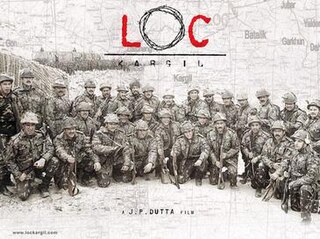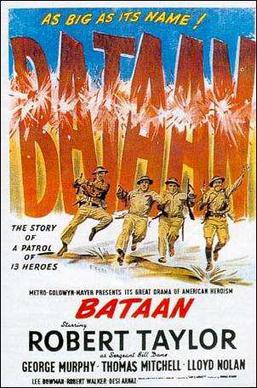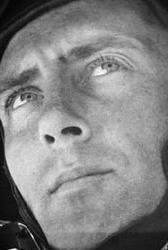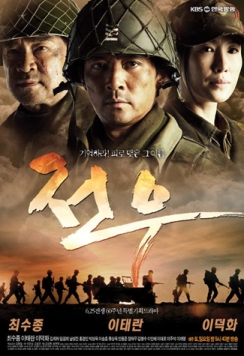
Platoon is a 1986 American war film written and directed by Oliver Stone, starring Tom Berenger, Willem Dafoe, Charlie Sheen, Keith David, Kevin Dillon, John C. McGinley, Forest Whitaker, and Johnny Depp. It is the first film of a trilogy of Vietnam War films directed by Stone, followed by Born on the Fourth of July (1989) and Heaven & Earth (1993). The film, based on Stone's experience from the war, follows a new U.S. Army volunteer (Sheen) serving in Vietnam while his Platoon Sergeant and his Squad Leader argue over the morality in the platoon and of the war itself.

The Thin Red Line is a 1998 American epic war film written and directed by Terrence Malick. It is the second screen adaptation of the 1962 novel of the same name by James Jones, following the 1964 film. Telling a fictionalized version of the Battle of Mount Austen, which was part of the Guadalcanal Campaign in the Pacific Theater of the Second World War, it portrays U.S. soldiers of C Company, 1st Battalion, 27th Infantry Regiment, 25th Infantry Division, played by Sean Penn, Jim Caviezel, Nick Nolte, Elias Koteas, and Ben Chaplin. The novel's title alludes to a line from Rudyard Kipling's poem "Tommy", from Barrack-Room Ballads, in which he calls British foot soldiers "the thin red line of heroes", referring to the stand of the 93rd Regiment in the Battle of Balaclava of the Crimean War.

Michael Strank was a United States Marine Corps sergeant who was killed in action during the Battle of Iwo Jima in World War II. He was one of the Marines who raised the second U.S. flag on Mount Suribachi on February 23, 1945, as shown in the iconic photograph Raising the Flag on Iwo Jima by photographer Joe Rosenthal. Of the six Marines depicted in the photo, Strank was the only one to be correctly identified from the beginning; the other five were either assigned the wrong locations, or, were given the names of Marines who were not in the photo.

A Walk in the Sun is a 1945 American war film based on the novel by Harry Brown, who was a writer for Yank, the Army Weekly based in England. The book was serialized in Liberty Magazine in October 1944.

The Battle of Ia Drang was the first major battle between the United States Army and the People's Army of Vietnam (PAVN), as part of the Pleiku Campaign conducted early in the Vietnam War, at the eastern foot of the Chu Pong Massif in the central highlands of Vietnam, in 1965. It is notable for being the first large scale helicopter air assault and also the first use of Boeing B-52 Stratofortress strategic bombers in a tactical support role. Ia Drang set the blueprint for the Vietnam War with the Americans relying on air mobility, artillery fire and close air support, while the PAVN neutralized that firepower by quickly engaging American forces at very close range.

We Were Soldiers is a 2002 American war film written and directed by Randall Wallace and starring Mel Gibson. Based on the book We Were Soldiers Once… and Young (1992) by Lieutenant General (Ret.) Hal Moore and reporter Joseph L. Galloway, it dramatizes the Battle of Ia Drang on November 14, 1965.

LOC Kargil is a 2003 Indian Hindi-language historical war film based on the Kargil War fought between India and Pakistan, produced and directed by J. P. Dutta under his banner "J. P. Films". The film features an ensemble cast of Bollywood stars and music composed by Aadesh Shrivastava and Anu Malik, with the former composing the score and the latter composing the songs.
Radio Battalions are tactical signals intelligence units of Marine Corps Intelligence. There are currently three operational Radio Battalions in the Marine Corps organization: 1st, 2nd, and 3rd. In fleet operations, teams from Radio Battalions are most often attached to the command element of Marine Expeditionary Units.

Bataan is a 1943 American black-and-white World War II film drama from Metro-Goldwyn-Mayer, produced by Irving Starr, and directed by Tay Garnett, that stars Robert Taylor, George Murphy, Lloyd Nolan, Thomas Mitchell, Desi Arnaz and Robert Walker. It follows the fates of a group of men charged with destroying a bridge during the doomed defense of the Bataan Peninsula by American forces in the Philippines against the invading Japanese.

Henry Oliver Hansen was a United States Marine Corps sergeant who was killed in action during the Battle of Iwo Jima in World War II. He was a member of the patrol that captured Mount Suribachi, where he helped raise the first U.S. flag on Iwo Jima on February 23, 1945. He was killed six days later.

Ernest Ivy "Boots" Thomas Jr. was a United States Marine Corps platoon sergeant who was killed in action during the Battle of Iwo Jima in World War II. He was awarded the Navy Cross for extraordinary heroism while fighting for and at the base of Mount Suribachi. Two days later he was a member of the patrol that captured the top of Mount Suribachi where he helped raise the first U.S. flag on Iwo Jima on February 23, 1945. He was killed eight days after that.
Harold George Schrier was a United States Marine Corps lieutenant colonel who served in World War II and the Korean War. In World War II, he was awarded the Navy Cross for leading the patrol that captured the top of Mount Suribachi, where he helped raise the first U.S. flag on Iwo Jima on February 23, 1945. In the Korean War, he was wounded in North Korea during the Battle of Chosin Reservoir while commanding a rifle company.
Charles W. Lindberg was a United States Marine Corps corporal who fought in three island campaigns during World War II. During the Battle of Iwo Jima, he was a member of the patrol which captured the top of Mount Suribachi where he helped raise the first U.S. flag on the island on February 23, 1945. Six days later, he was wounded in action.
Gung Ho! is a 1943 American war film directed by Ray Enright and starring Randolph Scott. The story is based somewhat on the real-life World War II Makin Island raid led by Lieutenant Colonel Evans Carlson's 2nd Marine Raider Battalion.

Attack, also known as Attack!, is a 1956 American war film directed by Robert Aldrich and starring Jack Palance, Eddie Albert, Lee Marvin, William Smithers, Robert Strauss, Richard Jaeckel, Buddy Ebsen and Peter van Eyck. The cinematographer was Joseph Biroc.

Castle Keep is a 1969 American war comedy-drama film combining surrealism with tragic realism. It was directed by Sydney Pollack, and starred Burt Lancaster, Patrick O'Neal, Jean-Pierre Aumont, Bruce Dern and Peter Falk. The film appeared in the summer of 1969, a few months before the premiere of Pollack's smash hit They Shoot Horses, Don't They?

Marine Raiders is a 1944 RKO war film showing a fictional depiction of the 1st Marine Raider Battalion and 1st Marine Parachute Battalion on Guadalcanal, R&R in Australia, retraining in Camp Elliott and a fictional attack in the Solomon Islands. Produced by Robert Fellows, and directed by Harold D. Schuster, it stars Pat O'Brien, Robert Ryan, and Ruth Hussey.

Legend of the Patriots is a remake of the 1975 South Korean drama Comrades. Its production was spawned to commemorate the 60th anniversary of the Korean War. The story centers around the lives of eleven Korean soldiers fighting in the Korean War. Director Kim Sang-hwi remarked that the series is not about the ideologies of South and North Korea, but rather focuses on the struggles of ordinary people who lived through the war.
Screaming Eagles is a 1956 American war film directed by Charles F. Haasd starring Tom Tryon, Jan Merlin and, in her film debut, French Miss Universe 1954 runner-up Jacqueline Beer. It was released by Allied Artists.
Company E, 52nd Infantry, (LRP) was a 120 man-sized long-range reconnaissance patrol unit attached to the 1st Cavalry Division (Airmobile) in Vietnam in 1967-69. Its origin begins on January 1, 1967, as "LRRP Detachment G2," 1st Cavalry Division (Airmobile). It was then redesignated "Headquarters & Headquarters Company LRRP Detachment" in April 1967, and redesignated "Company E, 52nd Infantry (LRP)" on December 20, 1967.













